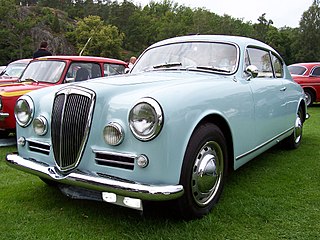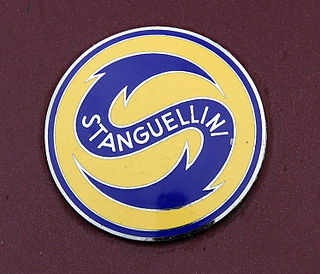Vehicles with Ala d'Oro bodies
Commercial vehicles
One of Ala d'Oro's main activities was the dismantling and conversion of military vehicles into civilian or commercial vehicles. This was a widespread business model in Italy in the immediate post-war period. [4] [5]
Sports cars
In addition to the (re)construction of commercial vehicles, Franco Bertani's company also built sports car bodies, although this only made up a small part of the production volume. Typical of the Ala d'Oro bodies were smooth car sides in the pontoon style and a sloping profile at the front and rear, reminiscent of an airplane wing. [6] Ala d'Oro's bodies were considered aerodynamically advanced. [2]
Stanguellini

Immediately after the start of operations, Franco Bertani made contact with the racing car manufacturer Stanguellini, for whose factory team he had competed in numerous races in the pre-war period. In 1947, Stanguellini launched the 1100 Sport, whose drivetrain and chassis technology was derived from the contemporary Fiat 1100. [7] In the following years, the 1100 Sport models received bodies primarily from Bertone, Pininfarina and Motto, but at least two cars were also bodied by Ala d'Oro:
Maserati
In 1947, Ala d'Oro fitted one of the first chassis of Maserati's A6GCS series (chassis number 2003) with a closed Berlinetta body on a factory order. The body was designed as a hatchback coupé with smooth sides. The wide, fully covered B-pillar continued seamlessly into the rear fenders. The A-pillar was exceptionally steep; the windshield was divided in two by a central bar. The doors were small, as were the side windows. The headlights were set into the front mask. [10]
Maserati's factory team took part in the Mille Miglia in May 1947 with this car and the drivers Luigi Villoresi and Guerino Bertocchi (starting number 222). The not yet fully developed car retired before the end of the race. [11]
After this race, the chassis received a new, open body, commissioned by a private customer. The Ala d'Oro body was destroyed in 1949.
Ermini

In 1948, Ala d'Oro built a Barchetta for the Florentine racing car manufacturer Ermini, which was based on a Fiat 1100 chassis and had a Fiat engine reworked by Ermini. The car, with the chassis number 214184, had a flat pontoon-style body with a horizontal beltline and rounded front and rear sections. As was usual with Ala d'Oro, the headlights were set far down in the front mask. The cooling air opening was oval in shape and had a grille. [11] Pasquale Ermini started with the car in the 1948 Mille Miglia. He did not finish; the car was badly damaged in an accident. Ermini sold the accident-damaged car to Camillo Rossi, who commissioned Carrozzeria Mariani to repair the body. Mariani designed a new front end with a square cooling air intake and a bulge above the rear wheels that interrupted the otherwise horizontal belt line. Rossi took part in the first edition of the Coppa della Toscana in 1949 with this car. The car exists today and still has the Mariani body.
Fiat
Ala d'Oro also built a racing car that was to be used by the factory under its own name. The car had a chassis from the Fiat 500 and a tuned engine from the Fiat 1100. However, it was not a sporting success. Ala d'Oro then sold the body design to other small racing car manufacturers such as Giannini, who partly prepared their cars with these bodies for use in the 750 cc class. [2]















